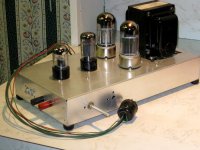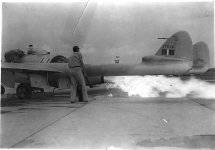Incoming flack:
https://frank.pocnet.net/sheets/093/6/6BQ7A.pdf
They don't seem to be rated for much plate V or very linear. They are cheap at least.
The gm curves versus grid voltage might sum to a near constant for differential mode with a resistive tail.
https://frank.pocnet.net/sheets/093/6/6BQ7A.pdf
They don't seem to be rated for much plate V or very linear. They are cheap at least.
The gm curves versus grid voltage might sum to a near constant for differential mode with a resistive tail.
Last edited:
I built only the power amp & driver section for 'Proof of Concept'. Power provided by lab power supplies. The iron is Hammond, similar to their 1650N, but one-half the primary impedance.
Too many other projects finished here on the shelf, don't need another I may never use.🙂. Especially at this age. Time to goof off.
Too many other projects finished here on the shelf, don't need another I may never use.🙂. Especially at this age. Time to goof off.
Attachments
I posted an old schematic but just as easily could have changed the tube designators to the octals. Main point is that the cct works either way. Best part it doesn't oscillate.🙂
For comparative measurements of D%, Etc check the Table A in 'Out of the Box' Part lll. The BQ7 family looks very good. Much better than audiophools would want us to believe!
For comparative measurements of D%, Etc check the Table A in 'Out of the Box' Part lll. The BQ7 family looks very good. Much better than audiophools would want us to believe!
Attachments
Incoming flack:
https://frank.pocnet.net/sheets/093/6/6BQ7A.pdf
They don't seem to be rated for much plate V or very linear. They are cheap at least.
The gm curves versus grid voltage might sum to a near constant for differential mode with a resistive tail.
6BQ7s seem to have a squirrelly plate characteristic (undocumented variable-mu?) but I've used them a for a cascoded LTP with active tail loading, and for that they work great. You can get the distortion estimates down by keeping VPK up.
Just watch out for the cheaper versions that connect the heaters in series: they ring like bells. The ones with parallel connected heaters don't seem to be especially microphonic.
- Status
- Not open for further replies.

